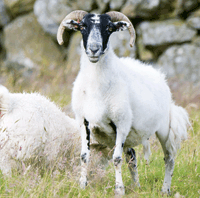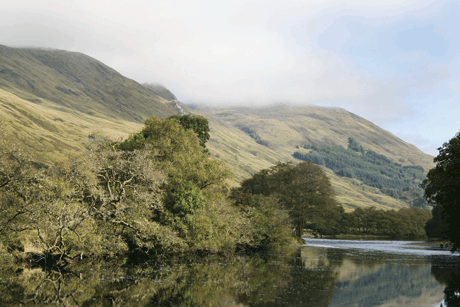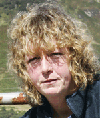VIDEO: Exodus threatens way of life for Scottish hill farmers

Sheep farmers are continuing to leave Scotland’s hills in their droves, according to latest statistics. Nancy Nicolson spends a day at a lamb sale on the west coast in a bid to gauge the mood and finds that it’s not just the stock that’s disappearing, it’s potentially a whole way of life
The tourists may gawp in wonder at the beauty of Lochaber’s high, misty mountains, but for the Blackface sheep which spend their lives grazing these steep slopes and the mountain men who manage the flocks and know the hills in all their moods, it is a harsh, wet and unforgiving place.
The gradient is steep, the terrain rough and the 120in of rainfall the highest in the country. Yet for generations these hills have symbolised a way of life for a resilient breed of people and their equally hardy livestock who can endure conditions which – by any measure – are physically and economically challenging. You don’t farm here to make a fortune but to subsist in a lifestyle that is based on family tradition and a unique sense of belonging.
But after generations of minimum change, there has been something akin to a revolution taking place here since the turn of the millennium. A decade of poor sheep sector returns, an ageing population and a lack of hope and confidence for the next generation has taken its toll with a wave of Highland Clearances which has seen tens of thousands of sheep sold from these hills and the remotest farms abandoned. Increased bureaucracy and the spectre of electronic identification mean the exodus is far from over.

Two independent reports in the past 18 months have focused on the rapid reduction in sheep numbers in many areas of the north west by between 35% and 60%. A Retreat from the Hills, a report from the Scottish Agricultural College, described the potentially negative consequences of this trend for the economic, social and environmental sustainability of upland areas. And an inquiry by the Royal Society of Edinburgh into the future of Scotland’s hills and upland areas concluded that the continuing decline in hill and island agriculture had implications for biodiversity, landscape management and food security.
The Argyllshire flockmasters who have held on to their sheep through the toughest times reflect in fearful tones about their future when they gather for seasonal lamb sales at Dalmally mart, a small cluster of pens and a ring on the outskirts of the Highland village just north of Oban. Prices have improved this season, but only to levels many were enjoying 20 years ago when producers also had the advantages of better subsidies and a decent wool cheque.
These men and women are not just sad to see the sheep come off the hills. The dispersals have had serious implications for the management of their own flocks.

Sybil MacPherson, vice-president of the National Sheep Association Scotland, runs Brackley Farm on the outskirts of Dalmally. It is stocked with 1200 Blackface ewes on hills which extend to 4000 acres and rise to 2800ft, and in the past 10 years 8000 breeding sheep have been taken off the neighbouring 50,000 acres.

The dwindling pool of neighbours to help with sheep work was the final straw for Robbie Campbell who recently sold 1400 ewes from remote Loch Treig farm near Corrour. He started life as a shepherd and worked his way into a tenancy but couldn’t cope with the years of depressed prices on top of the rigours of a hard, inaccessible unit.

The faces round Dalmally Mart’s ringside tell the story of an ageing farming population, and while there are sons looking on as their fathers sell, it tends to be as interested parties rather than full-time partners in the business. The president of the Blackface Sheep Breeders Association, John MacPherson, a third generation farmer in partnership with his brother on Balliemeanoch farm above Loch Awe, is a case in point. He has reduced his flock from 2200 to 1600 ewes in the past five years despite having a family which desperately wants to continue the tradition.
Despair over EID is not unique to Lochaber but, for those whose animals can roam over dozens of square miles, the prospect of having to comply with the new European rules is terrifying and is undoubtedly contributing to the flight from the hills. Producers refer to “black loss”, the 5-10% of animals which disappear into rivers or bogs and can never be accounted for in official returns.
Ironically, the recent rise in lamb prices appears only to be hastening the trend of ewe dispersals, with hill producers seeing a window of opportunity to get out. Mrs MacPherson, whose family has farmed at Brackley for 170 years, describes herself as one of the lucky ones as she doesn’t have an overdraft or the financial burdens of a tenanted farm.

Not everyone agrees that all is lost for sheep farming in these high hills of the west. Angus MacFadyen, chairman of Argyll and Bute Agricultural Forum and a member of NFU Scotland’s Regional Board, says that the improvement in prices is enough to encourage him to continue, but admits he has several other sources of income to subsidise his unit.
It is undeniably the case that Scotland’s stratified sheep industry needs the bedrock of production in these areas and that the lightweight lambs which leave Lochaber do well once they reach better soils and richer pastures. But much more is at stake for these remote communities if the flocks disappear from the hills.

Jamie MacGregor, another local sheep farmer, is also a Conservative member of the Scottish Parliament (MSP) and is concerned that, if the sheep disappear, so too will the rich biodiversity that depends on sustainable grazing. He believes the hills will revert to impenetrable scrub, making them less attractive to walkers and to the tourists who travel here in their droves to admire the scenery and soak up the culture of the area.
The clock is ticking. On the day of the last Dalmally sale news was spreading that another two hill farmers had decided to sell their flocks. The diehards who are left are getting ever fewer.
